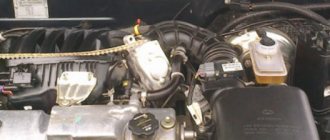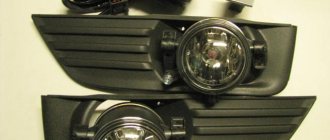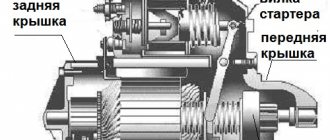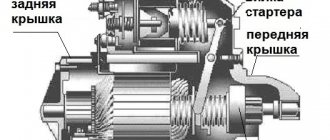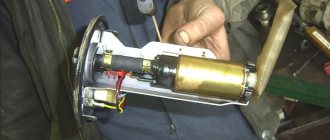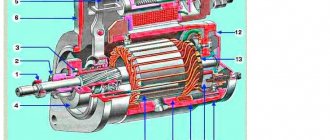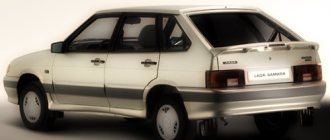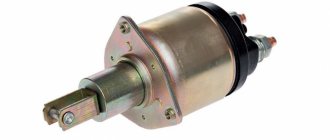Sometimes during the operation of the car, the driver may notice that the electronics in it have begun to act up, the heater and windshield wipers have begun to work intermittently, and the engine has difficulty starting. The cause of such problems, in most cases, is the small ignition relay 2114. In today’s article we will talk about what it is responsible for, where it is located and how to properly replace it.
Ignition relay VAZ 2114
212-2 Repair Focus I
Fuse and relay mounting blocks
To replace a fuse or relay, disconnect the negative cable terminal from the battery.
There are tongs on the cover of the additional block.
. with which we remove the fuses. Also on the cover, symbols show the location of the fuses, the electrical circuits they protect and the purpose of the relay. To access the interior fuse box.
. remove the cover. On its inside there are symbols indicating the circuits protected by fuses. It is more convenient to remove the fuse with pliers. To replace relays located in the mounting block above the fuses.
. Using a Phillips screwdriver, unscrew the five screws securing the shelf installed under the instrument panel on the driver’s side.
We move the shelf away from the instrument panel. The diagnostic connector block is fixed on the shelf.
Using a screwdriver, pry up the latch.
. remove the diagnostic connector block from the shelf.
Using a “7” head, unscrew the two bolts securing the mounting block to the bracket.
Press the two latches.
. remove the block from the bracket.
We replace the faulty relay.
Main mounting block located in the cabin
: 1 - fuse block (number, color, rated current of fuses, as well as protected circuits are indicated in the table); 2 - reserve; 3 - starter relay; 4 — relay for intermittent operation of the tailgate glass wiper; 5 — relay for intermittent operation of the windshield wiper; 6 — sound signal relay; 7 - time delay block relay; 8 - relay for heating the rear window/tailgate glass and exterior rear-view mirrors.
Additional mounting block located in the engine compartment
: 1 — fuse block (number, color, rated current of fuses, as well as protected circuits are indicated in the table); 2 - ignition relay; 3 - reserve; 4 — windshield heating relay; 5 — headlight high beam relay; 6 — low beam headlight relay; 7 — main relay of the engine control system; 8 — fuel pump relay; 9 — air conditioning compressor relay; 10 - reserve; 11 — relay for additional fan of the engine cooling system; 12 — engine cooling fan relay.
Fuse F65, which protects the central locking circuit, is installed on the back of the main mounting block. To remove some components, such as the brake master cylinder, it is necessary to remove the mounting block installed in the engine compartment. But the block does not have connecting connectors - the wires of the harness are connected to the terminals of each fuse and relay directly. This makes it more difficult to disconnect the wires from the unit. Therefore, in this situation, disconnect the battery.
. Using the “7” head, unscrew the self-tapping screw securing the block body.
. then press the two latches.
. remove the unit from the bracket and move it to the side without disconnecting the wires from it.
Relay and fuse box in the center console
Diagram of the relay and fuse box in the central instrument panel
Designation and numbering in the block
Location of the relay and fuse box in the console
Circuit breakers
| No. prev. | Ampere | Purpose |
| 1 | 15 A | ignition module, controller |
| 2 | 15 A | canister purge valve, vehicle speed sensor, oxygen sensor (heating) and air flow sensor |
| 3 | 15 A | fuel pump, injectors |
Relay
| Relay no. | vendor code | Purpose |
| 4 | electric fan | |
| 5 | electric fuel pump | |
| 6 | ignition |
Where is the ignition relay located in a VAZ-2114 car?
If a car owner independently monitors the technical serviceability of his four-wheeled friend, then he must feel his car and know exactly where this or that element is located in order to quickly replace a component that has become unusable with a new one.
For example, the driver may notice the following:
- the furnace fan will start to work intermittently;
- The windshield wiper and glass heating either turn on normally or refuse to work;
- the engine started to have trouble starting.
You should not immediately look for a breakdown in the starter or car module, because most often such a breakdown is caused by a starter relay that has become unusable. Experts do not recommend repairing such an element, since a failed element, even if it is thoroughly repaired, will very soon show signs of malfunction again, so the entire replacement operation will have to be repeated again. Replacing the so-called relay yourself is quite simple, but before doing this you should know exactly where the ignition relay is located on the VAZ-2114. We will deal with this issue, as well as with independent replacement of the “relay”, further in this article.
Ignition relay location
Finding the location of the ignition relay is quite simple, because this element in the VAZ-2114 injector is located on the left side of the steering wheel, and a decorative cover protects it from the eyes. A photo on an online resource will help you find out what this element looks like. In some cases, replacing an old relay with a new one does not require removing the protective casing. To do this, you just need to reach the relay with your hand, which you need to insert into a special hole located under the steering wheel.
But this replacement stage is not very convenient, so experts recommend that car owners still remove the protective cover when replacing the ignition relay, especially since such an operation is quite simple and easy.
Step-by-step replacement of the ignition relay
If during the inspection it turns out that the ignition switch relay has failed, then experts do not recommend repairing this element, as was previously said. To buy a new relay, minimal cash costs will be required, and every car enthusiast can make a replacement if all operations are carried out in stages:
- The most important thing to do first is to disconnect the battery from the power supply; to do this, simply disconnect the negative terminal from the battery.
- When using a screwdriver, it is best to use a slotted tool. You need to unscrew the 4 fasteners from the steering column casing to simplify the process of removing the “relay”.
- The latch holding the lower part of the casing is most conveniently unscrewed using a Phillips screwdriver.
- The casing, loosened from the fasteners, is carefully removed from its place.
- The ignition relay is connected to wires that are located at the bottom of the block. To replace an element that has become unusable, you simply disconnect the wires from the block and install a new one in place of the old relay.
After this, you need to check the result of your own work by starting the engine of your car. If the fault does not show itself, it means that the replacement process was completed correctly, and the car owner can be proud of his next, albeit small, but still achievement.
After reading this article, everyone should understand that the process of replacing this device is simple and straightforward. And since the “relay” rarely fails, VAZ-2114 owners do not constantly have to perform such an operation. But if difficulties arise when replacing the ignition switch relay, you should never despair, because you can find the answer to any question in a training video on the Internet resource, which you can watch both day and night.
The training video lesson was prepared and conducted by true professionals who thoroughly understand all stages of car repair. Therefore, everyone will be able to obtain additional information on replacing the relay and determine its exact location from the photo. Well, after watching the training video, the replacement process will become even simpler and you can be sure that every car enthusiast can handle this task.
Where is the ignition relay on the VAZ 2115 and how to find it
After the first unsuccessful attempts to start the car engine with the ignition key, without hearing the usual sounds of the starter, most car enthusiasts look for the cause of the malfunction in its breakdown. However, more often the cause is the ignition relay.
Why do you need an ignition relay?
This part was also installed on previous models of VAZ cars. However, on early versions of 2115 it may be absent. It is present in the starter circuit on VAZ-2115-01, 20, 21, 22 (injector, carburetor).
There are different names for this part: ignition relay, starter relay, starter interlock, ignition switch or lock relay, main relay.
But in any case, its purpose is the same - to facilitate engine starting and protect the starter from wear and damage. It turns off the power to the electric starter after starting the engine, limits the currents flowing through it, and protects against caking of contacts in the ignition switch or turning the key while the engine is running.
In addition, it ensures starting of the starter when the vehicle's electrical equipment is turned on and the battery is slightly discharged.
There are no fuses in the ignition circuit of cars of this model.
Thus, this inexpensive part protects you from expensive repairs and makes it easier to start the engine.
This part should not be confused with the retractor relay, located directly on the starter and intended to control (pulling or pushing) the mechanism for engaging the teeth of the electric starter and the flywheel.
Signs of breakdown
If, when you turn the ignition key, the electric starter does not spin, but you can hear soft clicks of the relay contacts operating, then the cause of the car malfunction is the starter. You can verify this by connecting it directly to the battery, bypassing this electric relay. If clicks are not heard, and the starter is working properly, then it’s time to change it.
Where is
Where is the VAZ-2115 ignition relay located? It is located in the car interior, to the left of the steering column, under the instrument panel. In order to see it, you need to dismantle the instrument panel. Nearby, to the left of it, there is a relay for turning on the rear fog lights. They are screwed onto the car body stud with a “10” nut and located in special blocks.
The relay also controls the vehicle's washer, heater, rear window defroster, and some other low-current electrical circuits. If these vehicle components are not operating properly, the serviceability of this part should be checked.
The type of electric ignition relay is 90.3777-10, it has four contacts, the control voltage is 12 volts. When buying a new relay, be careful: five-pin analogs designed for 24 volts have a similar appearance. Self-repair of this part is unprofitable due to its low cost.
Video: “Ignition relay VAZ-2115: where is it located?”
If you installed it yourself
The previous owner of the car, in the absence of such a standard part, could install it himself. Such installation kits are sold in car dealerships. In this case, the electric relay can be located not only in the “standard” location. Finding it without calling the previous owner will not be so easy.
If a breakdown of this part occurs on the way, then you can start the car by closing contacts 87 and 30 (the location and circuit diagram are printed on the top of the relay housing). In this case, you are allowed to use the machine without any restrictions. But at the first opportunity, be sure to fix the breakdown. The operation of the VAZ-2115 ignition system directly depends on the relay.
Additional block
It is located under the center console and is covered with a lid. One part is accessible from the right side.
Scheme
Designation
- 15A - Ignition module, controller
- 15A - Canister purge valve, vehicle speed sensor, oxygen concentration sensor (heating), air flow sensor
- 15A - fuel pump, fuel pump fuse, injectors
- Electric fan relay
- Fuel pump relay
- Main relay (ignition relay)
The other part is on the left side of the console:
Scheme
Decoding
- Central locking control unit
- Immobilizer block
- Relay for turning on rear fog lights.
This is interesting: How to check the generator on a VAZ
Lada 2114 ▲Kompressor▲ с416мр47 › Logbook › Replacing the ignition relay for a VAZ 2114
Firework! Thank you for reading this post! An entry on how to change the ignition relay
in a VAZ 2114. This relay haunted me in the form of either
the heater (heater) fan
or not, and the windshield wipers and heated rear window did not work normally either. After replacement everything works as it should. The previous relay was from the factory and worked for almost 7 years. This surprised me.
Lada 2114 2007, petrol engine 1.6 l., 80 l. p., front wheel drive, manual transmission - do it yourself
Cars for sale
Lada 2114 Samara, 2012
Lada 2114 Samara, 2006
Lada 2114 Samara, 2006
Lada 2114 Samara, 2005
Comments 133
Hello, I have a VAZ 2114. The plus on the ignition module has disappeared, where would you recommend dropping the engine control relay? I changed the fuses in order. When I turn the key, the switches click, but there is no plus on the ignition module.
Contact an electrician
Greetings. I have a VAZ 21120. The problem here is that I started the engine, turn it off, but it does not stall, I took out the key, but the engine and the tidy are working, turn it off by paying attention to the main relay. At the same time, I put a new relay on 30a, nothing changes, I put a relay from Ford on 40a, everything works in normal, normal mode, but the engine does not start. What could this be, please tell me
Good day, friends! Greetings from Kazakhstan! The problem is the cooling fan not working. I changed the temperature sensor, removed the fan sensor chip, it was in the way. I assembled everything, and when the highest temperature is reached, I wait for the fan to turn on. It won't turn on. I had to resort to forcibly turning on the fan by disconnecting the sensor chip. The car is a VAZ 2114. If you had such a problem, please share. C/u Timur. I will be immensely grateful.
If there is no signal sent to the engine coolant radiator fan, then it is either the coolant sensor, or the fan relay, or a fuse, or the ECU does not give a turn-on signal. IMHO.
Good day, can you tell me what I might have a VAZ 2114, a week ago the car sat for a day and wouldn’t start, after 2 days I decided to try to start it - it started as if nothing had happened, I drove for a week, the same situation, the car didn’t start for a day again won’t start, the fuel pump is fine It buzzes, the starter turns but there is no spark... I drove it every day. Dampness and rain outside, but what does this affect? Maybe they sent me a relay to see what else it could be?
Good afternoon I have a VAZ 2114. When accelerating sharply, the car accelerates too quickly, then stops, and the traction disappears. I stop, the speed freezes at 2000 rpm, and does not drop. Who had this problem? Please tell me. I will be immensely grateful. Best regards, Timur.
Do they drop when you turn off the ignition?
Yes. The car stalls with a shudder. When restarted it will start.
I would check the timing marks first.
Timing marks? I didn't think so. Thanks Pavel. I'll check and write an answer.
I had something similar on the 2114. It turned out that the generator pulley on the crankshaft had shifted a little, cutting off the pin.
That's it. I'm okay with this. Following your advice, I turned the crankshaft. The belt fell off by two teeth. Thank you very much. The check did not go out, I think there was some kind of error. But the engine began to run smoother.
PavelDotsenko
Do they drop when you turn off the ignition?
The revs fluctuate a little and it stays fine.
I would reset the battery terminal for a few minutes. Then I would check the VUT valve and the VUT hose.
I will definitely do it. But explain what VUT is.
PavelDotsenko
I would reset the battery terminal for a few minutes. Then I would check the VUT valve and the VUT hose.
Isn't this a vacuum cleaner?
PavelDotsenko
I would reset the battery terminal for a few minutes. Then I would check the VUT valve and the VUT hose.
Lada 2000, 78 l. With. — electronics
Omsk
Lada 2111, 2001
49 000 ₽
Bratsk
Lada 2111, 1999
80 000 ₽
Rainbow
Lada 2111, 2001
60 000 ₽
Iskitim
Lada 2111, 2006
70 000 ₽
See more cars on Drome
Participate in the discussion can only registered users.
Login Register
Ignition relay VAZ 2107: all the secrets
Small and inconspicuous parts of the car are almost always ignored by drivers, because the chassis or the engine itself seem more important and require special care. However, big problems with the car most often arise due to some “little thing” - for example, the ignition relay. This is a miniature device that plays a very important role on the VAZ 2107.
Ignition relay VAZ 2107
The very first versions of the VAZ did not have a fuse and relay block, that is, power was supplied to the coil through the ignition switch itself. Such a motor starting system “ate up” a lot of electricity, and the contacts quickly oxidized and stopped functioning normally.
The VAZ 2107 is equipped with a modern ignition relay. Its main function is to reduce the load on the contacts when turning on the device, since the relay turns off some electrical circuits at the moment of startup. The ignition relay is used in both carburetor and injection VAZ 2107 models.
Principle of operation
The ignition relay is one of the elements of the entire ignition system. This system consists of:
- spark plugs;
- distributor;
- capacitor;
- breaker cam;
- coils;
- mounting block;
- switch.
When the engine starts, power from the spark plugs goes to the ignition relay, which switches energy from some circuits. Thanks to this, the coil is supplied with the amount of power that is necessary to start the engine normally. To ensure uniform current supply, the relay works directly with the distributor and capacitor.
Relay location in the car
Any problems with the ignition relay on a VAZ 2107 begin with the fact that the driver cannot start the engine the first time. Suspicions immediately arise regarding the performance of certain components, but, as a rule, the relay is the first thing to be checked. On the “seven” it is located immediately behind the instrument panel and is fixed under the dashboard. This arrangement cannot be called convenient, because to get to the relay, you will need to remove the entire dashboard.
Relay design, designation and parameters
An electromagnetic relay is actively used to control various actuators, switch circuits, and control devices in electronics.
The relay design is quite simple. Its basis is a coil consisting of a large number of turns of insulated wire.
soft iron rod is installed inside the coil The result is an electromagnet. There is also an anchor . It is attached to a spring contact . The spring contact itself is fixed to the yoke . Together with the rod and the armature, the yoke forms a magnetic circuit.
If the coil is connected to a current source, the resulting magnetic field magnetizes the core. He, in turn, attracts the anchor. The anchor is mounted on a spring contact. Next, the spring contact closes with another fixed contact. Depending on the relay design, the armature may mechanically control the contacts differently.
Relay device.
In most cases, the relay is mounted in a protective housing. It can be either metal or plastic. Let's look at the relay device more clearly, using the example of an imported electromagnetic relay Bestar . Let's take a look at what's inside this relay.
Here is the relay without the protective housing. As you can see, the relay has a coil, a rod, a spring contact on which the armature is attached, as well as actuating contacts.
On circuit diagrams, an electromagnetic relay is designated as follows.
The relay symbol in the diagram consists of two parts. One part ( K1 ) is the symbol of the electromagnetic coil. It is designated as a rectangle with two terminals. The second part ( K1.1 ; K1.2 ) are groups of contacts controlled by the relay. Depending on its complexity, a relay can have a fairly large number of switched contacts. They are divided into groups. As you can see, the designation shows two groups of contacts (K1.1 and K1.2).
How does a relay work?
The principle of operation of the relay is clearly illustrated by the following diagram. There is a control circuit. This is the electromagnetic relay K1 itself, the switch SA1 and the power battery G1. There is also an actuator circuit that is controlled by a relay. The executive circuit consists of load HL1 (signal lamp), relay contacts K1.1 and battery G2. The load can be, for example, an electric lamp or an electric motor. In this case, the HL1 signal lamp is used as a load.
As soon as we close the control circuit with switch SA1, current from power battery G1 will flow to relay K1. The relay will operate and its contacts K1.1 will close the actuator circuit. The load will receive power from battery G2 and lamp HL1 will light up. If you open the circuit with switch SA1, then the supply voltage will be removed from relay K1 and the contacts of relay K1.1 will open again and the lamp HL1 will turn off.
Switched relay contacts can have their own design. For example, a distinction is made between normally open contacts, normally closed contacts and switching contacts. Let's look at this in more detail.
Normally open contacts
Normally open contacts are relay contacts that remain open until current flows through the relay coil. To put it simply, when the relay is turned off, the contacts are also open. In diagrams, relays with normally open contacts are designated like this.
Normally closed contacts
Normally closed contacts are relay contacts that remain closed until current flows through the relay coil. Thus, it turns out that when the relay is turned off, the contacts are closed. Such contacts are shown in the diagrams as follows.
Switching contacts
Switching contacts are a combination of normally closed and normally open contacts. Switching contacts have a common wire that switches from one contact to another.

